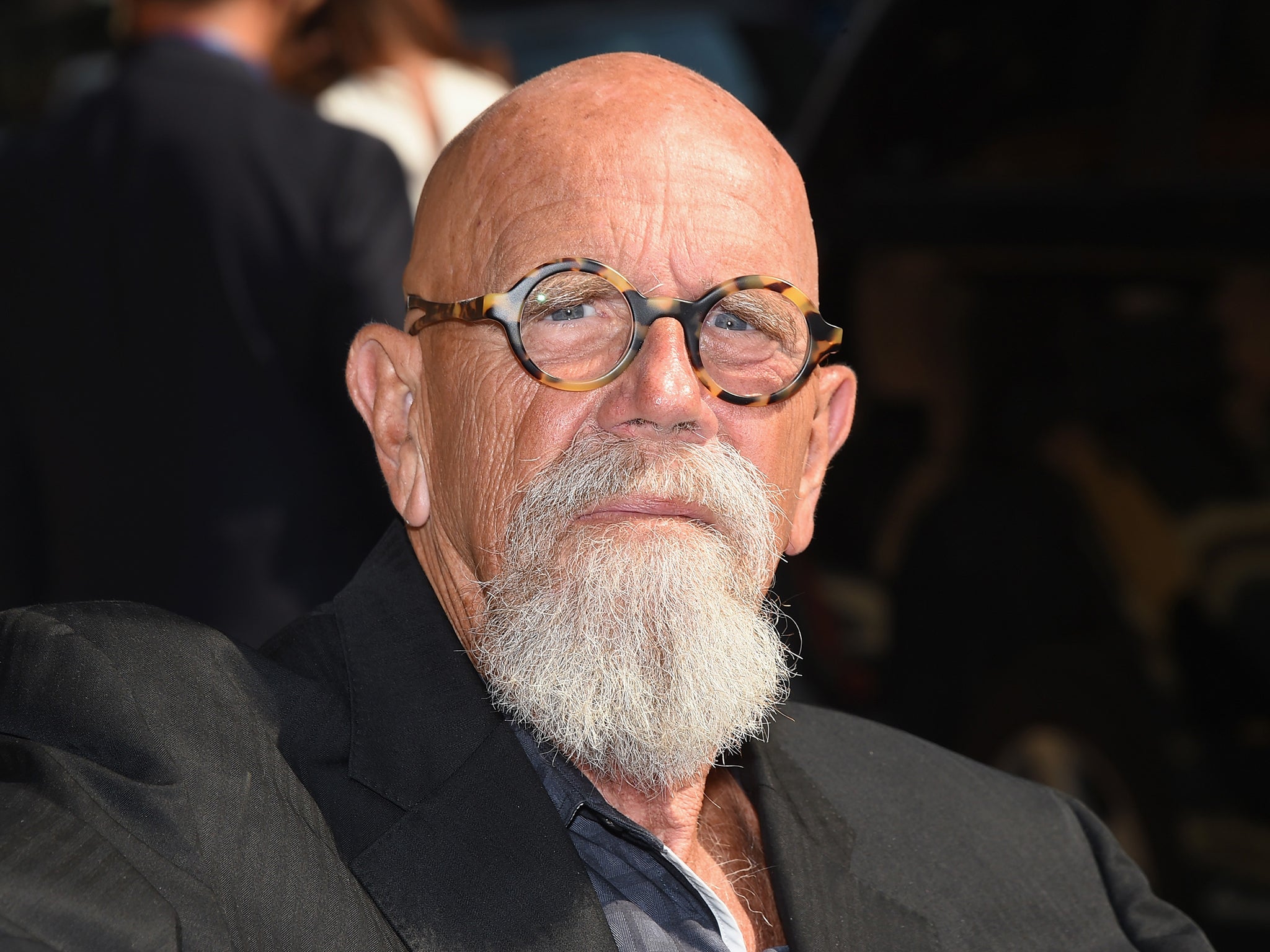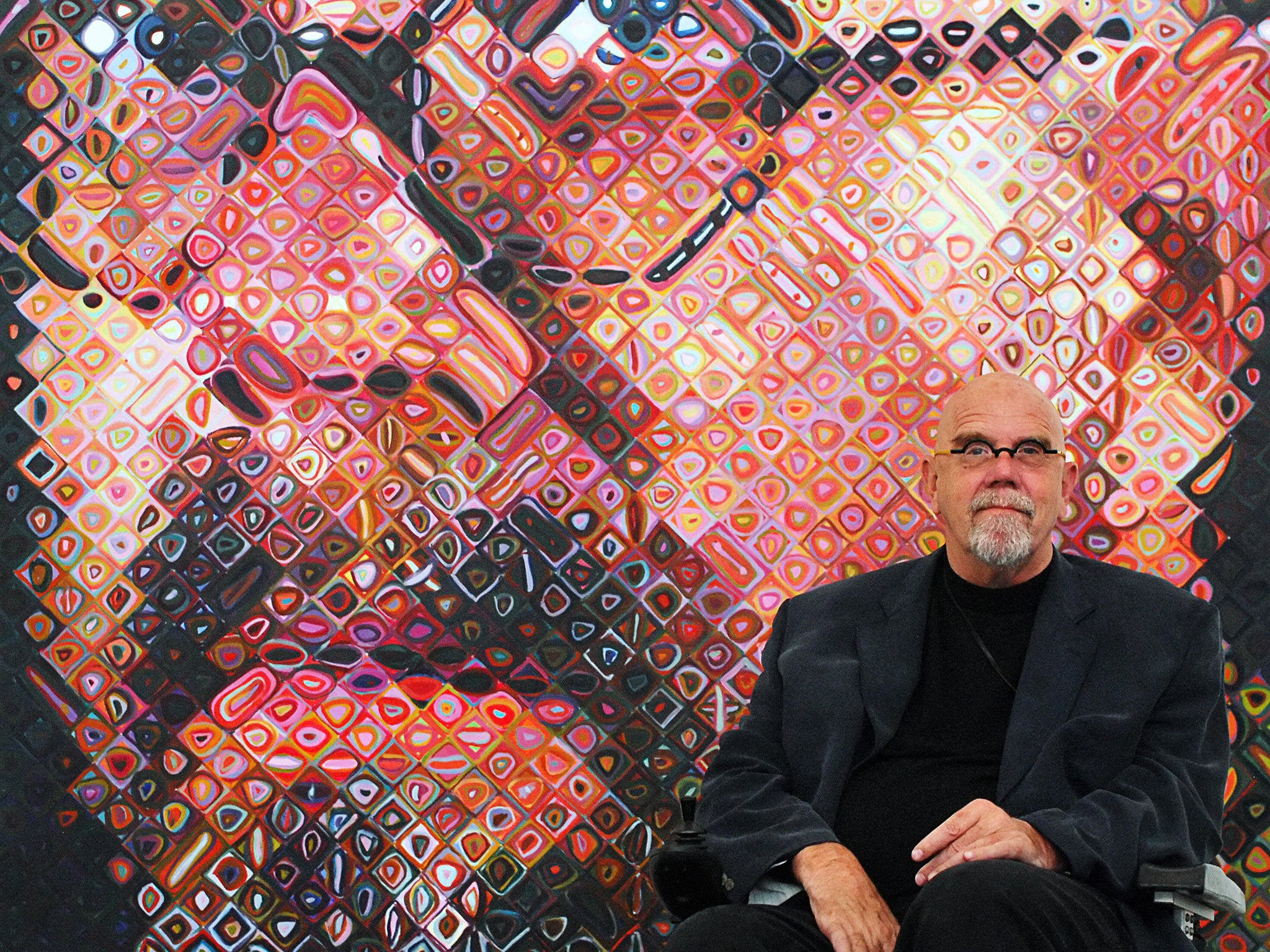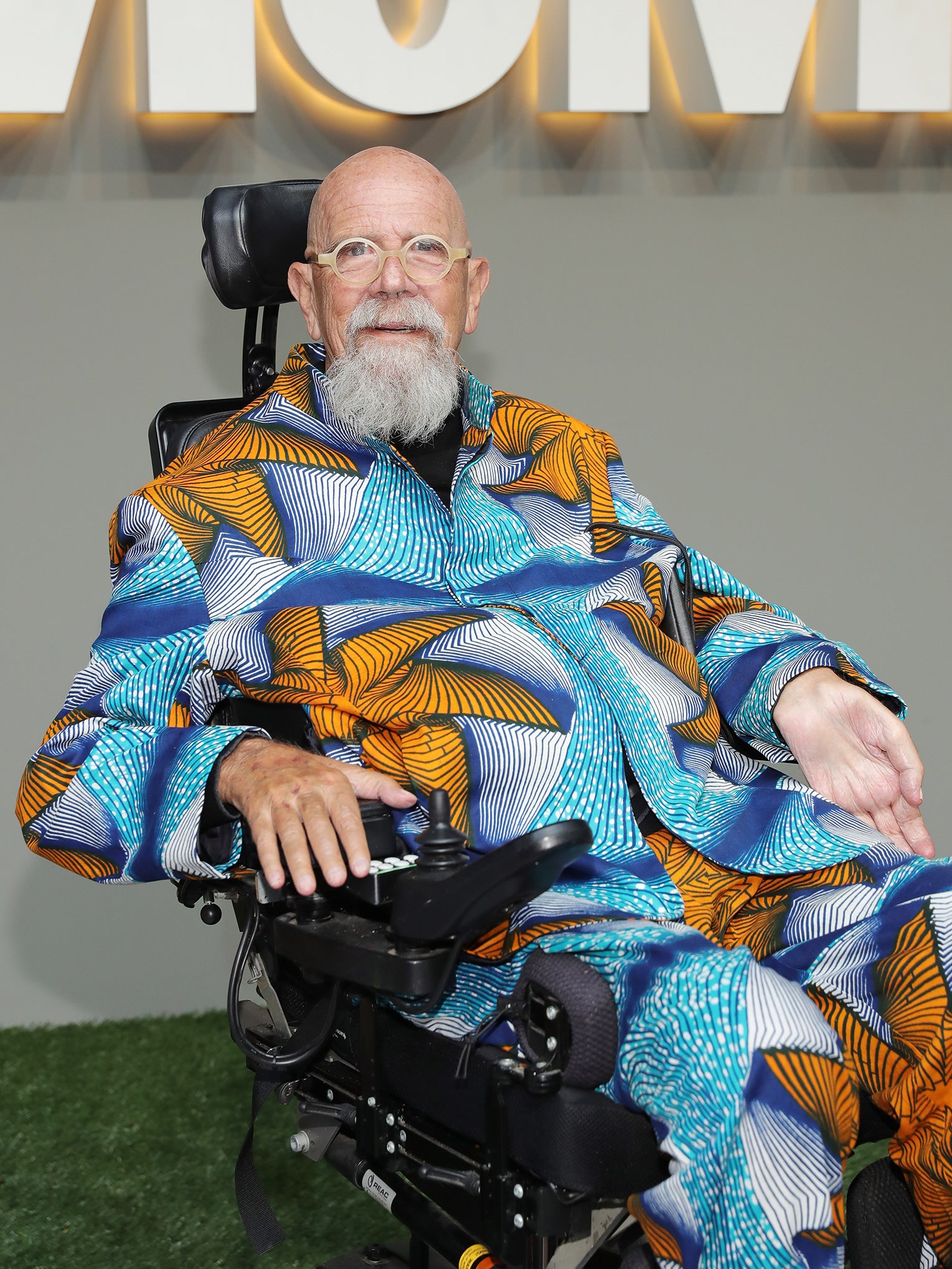Chuck Close: Controversial painter of pixelated portraits
Fred A Bernstein on the artist who found ways to use technology to expand his body of work

Chuck Close, whose larger-than-life portraits, some composed of thousands of small but intricate paintings that served as pixels, made him one of the most renowned artists of the past five decades and who continued to paint even after a 1988 spinal artery collapse left him severely disabled, has died aged 81.
Close’s career was marred late in his life – but not derailed – by charges that he had made unwanted advances to women he invited to his studio. Following the disclosures in 2017, the National Gallery of Art in Washington cancelled a show of his work but many others (including the National Gallery) continued to display his striking, oversized paintings.
Close generally painted from photographs. People think “you’re cheating” and that, “once you accept the photograph there’s only one way to do the painting,” he said in filmmaker Marion Cajori’s 1998 documentary Chuck Close: A Portrait in Progress. But he proved otherwise, improvising tiny paintings in each “cell”, or pixel.
Those tiny paintings drew on art history. In any given cell, “You might have a little Rembrandt, you might have a little Klimt, and all of it is synthesised to a system which is absolutely and totally Chuck’s own,” Robert Storr, an eminent art curator and critic, said in the documentary.
In 2004, art critic Helen A Harrison, writing in The New York Times, compared Close’s fragmented images, “to mosaics, with their discrete blocks of colour combining to make recognisable forms, and to Georges Seurat’s pointillism, which relies on the viewer’s eye to make sense of the scene”.
But Close said he was also influenced by his grandmother’s needlework, which included sewing crocheted stars into tablecloths.
She “made big, complicated things out of small pieces”, he recalled, noting that she could leave her work, then return hours or days later to exactly where she had left off. Close worked in a similar fashion, completing one pixel at a time, sometimes over a period of months.
His paintings of faces were too detailed and tightly cropped to be flattering. “I do believe that the face is a road map of the person’s life,” Close said in the documentary. He also observed that his fascination with faces may have arisen from his experience with prosopagnosia, or face blindness, and his desire to commit to memory the faces of family members and friends.
“Face blindness has plagued me since I was a child,” Close said in an interview with Brain & Life magazine in 2011. “I wouldn’t know my classmates. At the end of the school year, I would still have trouble recognising them.”
Art critic Wil S Hylton wrote in 2016: “The great insight of Close’s work has been to make portraiture vivid by removing detail, forcing viewers to contribute their own perception to the process.”

Charles Thomas Close was born in Monroe, Washington, on 5 July, 1940. He told the publication Artnews he was close to his father, a plumber and inventor who “made me things – toys from scratch, whole bicycles from scratch”. For his fifth Christmas, his father made him an easel and his parents later arranged for him to take art lessons at home.
He was 11 when his father died and his mother, a concert pianist, continued to support her only child’s interest in art – an interest he gravitated toward while he struggled in other classes because of undiagnosed dyslexia.
Later, he lost almost a year of school to nephritis, a kidney infection and his mother was diagnosed with cancer. Medical costs caused them to lose their house.
He graduated in 1962 from the University of Washington School of Art, then received a bachelor’s degree and a master’s of fine arts from Yale University. His Yale classmates included Brice Marden, Richard Serra, Jennifer Bartlett and Robert Mangold, all of whom became prominent artists (and many of whom he painted).
He studied at the Academy of Fine Arts Vienna on a Fulbright grant, taught art at the University of Massachusetts, then moved to New York in 1967. One of his students, Leslie Rose, came with him; they married a few months later.
In those days, Close imitated Willem de Kooning, perhaps the leading abstract expressionist painter, to such an extent that Close said he had to find a way to “purge de Kooning from my work”. He did that by imposing limitations including abandoning the paintbrush. “I threw away my tools,” Close told the Cleveland Plain Dealer. “I chose to do things I had no facility with.” He began working with an airbrush and using only black paint.
To create a painting from a photo, he would draw a grid on the photo and a larger version of the grid on a blank canvas. In the early days, he would erase the grid after finishing the painting, but around 1970 he began letting it show, embracing rather than obscuring his process.
He also began incorporating colour, applying successive layers of cyan, magenta and yellow paint, in imitation of colour printing, thus further removing his work from the seeming spontaneity of such “expressive” painters as De Kooning.
Close’s first solo exhibition was held in 1967 at the art gallery at the University of Massachusetts at Amherst, where he was then teaching. The university administration deemed several male nudes obscene and sent campus police to dismantle the show. The American Civil Liberties Union and the American Association of University Professors sued on Close’s behalf. He won at trial but that decision was overturned on appeal. Nearly 30 years later, he was awarded an honorary doctorate by the university.

Around that time, he spent four months painting Big Self-Portrait, an approximately 7ft x 9ft black-on-white enlargement of his face. “I wanted to make a big, aggressive, confrontational image”, that would, “suck the viewer right up close to it”, he said in the documentary. Asked why he chose to paint himself, Close remarked: “I was the only person in the room.” The painting, predating Close’s “pixelated” style, was made with black acrylic paint sprayed on to the canvas to achieve a photorealist effect. A cigarette is front and centre.
In 1969, the Walker Art Centre in Minneapolis bought Big Self-Portrait – the first painting he sold – for about $1,000 (£720). Close was soon showing in galleries around the world and, in 2015, one of his self-portraits sold for $2.4m at auction.
On 7 December 1988, Close was about to give a speech when he felt a strange pain in his chest. He delivered the speech, then walked to a nearby hospital, where he suffered a seizure.
“The event,” as he called it, was diagnosed as a spinal artery collapse. It left him almost completely paralysed from the neck down. He spent months undergoing rehabilitation, regaining some use of his limbs.
He considered giving up painting but then, he told Hylton, “I thought, ‘I’m going to get the paint on the canvas if I have to spit the paint on the canvas’.”
A studio was set up at the rehabilitation facility and Close learned to paint with a brush strapped to his right hand. But he used a wheelchair for the rest of his life. The sums fetched by his paintings made it possible to adapt his studios – in Manhattan and the Hamptons (and in his later years in Miami and Long Beach) – to his disability. Machines moved the large canvases so he could reach each part of them while seated.
In 2017, HuffPost and the New York Times published the accounts of women who said Close had invited them to his studio to talk about art, then asked them to undress. In one case, he was said to have made sexually explicit comments about a woman’s body.
In subsequent interviews, he apologised for making the women feel uncomfortable. “If I embarrassed anyone or made them feel uncomfortable, I am truly sorry,” he said. “I didn’t mean to. I acknowledge having a dirty mouth but we’re all adults.”
He also referenced his disability, saying that, “given my extreme physical limitations, I have found that utter frankness is the only way to have a personal life”.
But when the National Gallery of Art cancelled a small show of his work scheduled for 2018, he said: “It’s lies ... I’ve been such a supporter of women and women artists. I’ve done nothing wrong and I’m being crucified.”
He continued painting and found ways to use technology to expand his body of work. He had about 10,000 of his hand-painted marks scanned into a computer. Then he digitally rearranged them to produce portraits, including likenesses of the artists Cecily Brown, Kiki Smith, Cindy Sherman and Kara Walker. He was a 2000 National Medal of Arts recipient.
Close’s marriage to Leslie Close ended in divorce, as did a much shorter marriage to artist Sienna Shields. Survivors include two daughters from his first marriage and four grandchildren.
In the 1998 documentary, Close said that when he first tried painting after becoming paralysed, he would often break down and cry. But he realised that while he couldn’t do many of the things he loved doing – “swim in the ocean, walk on the beach, roughhouse on the grass with my kids” – he could still make art.
“Aside from my family and friends,” he said, painting, “means the most to me”.
Chuck Close, painter, born 5 July, 1940, died 19 August 2021.
© The Washington Post

